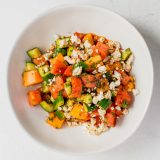When Rick Bayless wants to eat chili-lime fruit salad in Mexico City, he heads for the Parque Mexico, expansive urban gardens threaded by winding pathways and dotted by carts selling the popular street snack.
It’s a customized experience. The covered carts are stocked with a selection of cut fruit displayed behind glass, from which customers assemble their salads. Melon is common. Mangos, too, if they are in season. There’s almost always jicama for crunch, as well as the signature seasoning of lime, powdered chili and a dash of salt.
Part of the appeal is the way the salad varies with the time of year. If there’s a fruit in season “and it’s cut-up-able, then it will be in those carts,” says Bayless, the chef-owner at Topolobampo, the upscale Mexican restaurant in Chicago that was named best in the nation by the James Beard Foundation this year.
Bayless looks to see which vendors have real Key limes; he likes a good squeeze of the juice over his salad. And he’ll take in the impressive displays of carved fruit that cart owners put up in an effort to stand out from the crowd.
Then comes the best part—biting into the unique mix of flavors and textures—sweet meets salt meets (gentle) spice meets cool, fleshy fruit.
What should be cacophony turns into a harmonious whole.
“The seasonings all hit your tongue, in the perfect version, in a beautifully balanced way. You have the spicy, the salty and the acidic, but then there’s the sweetness from the fruit or the jicama or whatever,” says Bayless. There’s no bitterness, so the salad doesn’t hit the full symphony of taste categories, but there’s plenty going on. “It’s really fun to eat because your tongue is basically firing on all cylinders.”
At Milk Street, we wanted to devise a home cook-friendly version. And we wanted to keep things simple. That ruled out elaborate prep, so no finicky melon balls. Cubes were the easiest way to maintain a good fruit-to-spice ratio.
Likewise, regular chili powder was a no-go. It’s typically a blend of chilies plus other seasonings like cumin, oregano and garlic that fight with fresh fruit. Chipotle powder was too smoky; arbol chilies worked but can be hard to find. New Mexico chili powder also worked, but we ultimately liked ancho chili powder; the mild, dried chili is easy to come by and gave us the earthy, fruity complexity we wanted. We toasted it to heighten its impact.
In Mexico, the salads can include just about anything, including papaya, orange, mango and jicama. With simplicity in mind, we stuck with three choices. Cantaloupe and watermelon were obvious. For the third, we liked honeydew, but cucumber was better. The crisp vegetable balanced the sweetness of the melons and better paired the salad with savory dishes.
In Mexico, the chili-lime-salt combo is so popular there’s a branded version called Tajín. We tried it and took note of the bold lime component. For our recipe, we used 1 teaspoon lime zest as well as ¼ cup lime juice. To round out the flavors, 3 tablespoons of light agave syrup worked well, though a mild honey such as clover can be substituted.
We considered adding cilantro but found that the powerful (and polarizing) herb overwhelmed the dish. But ¼ cup of chopped fresh mint added freshness.
Our salad was good, but there was room for one more layer of flavor and contrast. Many recipes include a garnish of queso fresco, the crumbly, fresh Mexican cheese. We tried that and were won over by its salty flavor and creamy texture. If you can’t find queso fresco, feta works; just omit the ½ teaspoon of salt used to season the cheese.




